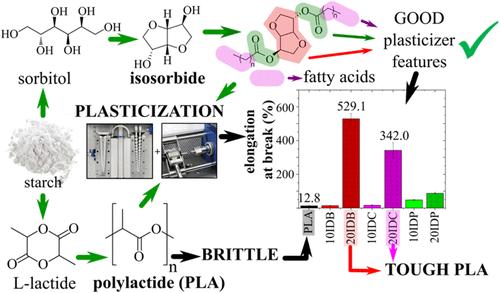用生物基异山梨酯和脂肪酸酯克服聚乳酸脆性的可持续方法
IF 7.3
1区 化学
Q1 CHEMISTRY, MULTIDISCIPLINARY
引用次数: 0
摘要
本文报道了从植物基异山梨酯中设计和合成可持续增塑剂以提高聚乳酸(PLA)的固有脆性。为了保持完全的生物基碳,异山梨酯与不同链长的脂肪酸酯化,得到异山梨酯二丁酸酯(IDB)、异山梨酯二丙烯酸酯(IDC)和异山梨酯二棕榈酸酯(IDP)。这些酯以不同浓度掺入聚乳酸中。通过计算溶解度参数(δ)和Flory-Huggins相互作用参数(χ)来评估pla -增塑剂的混相性。还讨论了增塑剂的种类和浓度对机械、热、热力学性能以及微观结构和生物降解的影响。结果表明,IDB和IDC显著提高了PLA的韧性,当IDC为20%时,PLA的玻璃化转变温度(Tg)从60.3℃降低到27.7℃。因此,当IDB或IDC为20%时,断裂应变从12.8% (PLA)急剧增加到300%以上。相比之下,IDP表现出有限的混相,导致相分离,尽管它仍然提高了冲击强度和塑性。所有配方都表现出在堆肥土壤中的特殊分解,强调了它们作为适用于PLA的“双绿”增塑剂的潜力。由于聚乳酸和异山梨酯都可以从淀粉中工业提取,因此这项工作将淀粉作为可持续聚合物的关键平台。本文章由计算机程序翻译,如有差异,请以英文原文为准。

Sustainable Approach to Overcome Polylactide Brittleness with Biobased Esters of Isosorbide and Fatty Acids
This work reports on the design and synthesis of sustainable plasticizers from plant-based isosorbide to enhance the intrinsic brittleness of polylactide (PLA). To keep fully biobased carbon, isosorbide was esterified with fatty acids of varying chain length, leading to isosorbide dibutyrate (IDB), dicaprylate (IDC), and dipalmitate (IDP). These esters were incorporated into PLA at different concentrations. An approach to assess PLA-plasticizer miscibility was conducted by calculating solubility parameters (δ) and the Flory–Huggins interaction parameter, χ. The effect of plasticizer type and concentration on mechanical, thermal, and thermomechanical properties, as well as on microstructure and biodegradation, was also addressed. The results indicated that IDB and IDC notably enhanced PLA toughness, reducing the PLA’s glass transition temperature (Tg) from 60.3 to 27.7 °C with 20 wt % IDC. Consequently, strain at break dramatically increased from 12.8% (PLA) to over 300% with 20 wt % IDB or IDC. In contrast, IDP exhibited limited miscibility, resulting in phase separation, though it still improved the impact strength and ductility. All formulations demonstrated exceptional disintegration in compost soil, underscoring their potential as “double green” plasticizers suitable for PLA. Since both PLA and isosorbide can be industrially derived from starch, this work places starch as a key platform for sustainable polymers.
求助全文
通过发布文献求助,成功后即可免费获取论文全文。
去求助
来源期刊

ACS Sustainable Chemistry & Engineering
CHEMISTRY, MULTIDISCIPLINARY-ENGINEERING, CHEMICAL
CiteScore
13.80
自引率
4.80%
发文量
1470
审稿时长
1.7 months
期刊介绍:
ACS Sustainable Chemistry & Engineering is a prestigious weekly peer-reviewed scientific journal published by the American Chemical Society. Dedicated to advancing the principles of green chemistry and green engineering, it covers a wide array of research topics including green chemistry, green engineering, biomass, alternative energy, and life cycle assessment.
The journal welcomes submissions in various formats, including Letters, Articles, Features, and Perspectives (Reviews), that address the challenges of sustainability in the chemical enterprise and contribute to the advancement of sustainable practices. Join us in shaping the future of sustainable chemistry and engineering.
 求助内容:
求助内容: 应助结果提醒方式:
应助结果提醒方式:


